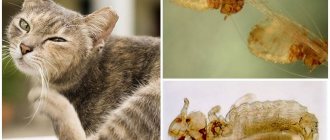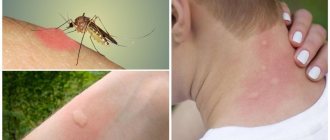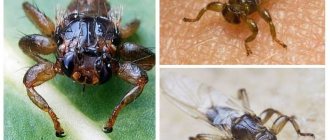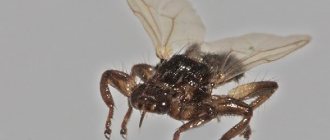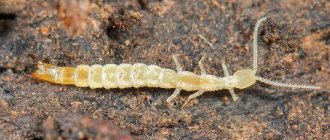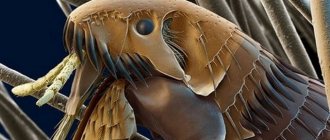Features of ticks
These creatures are temporary parasites of people and animals, since they do not live on the body of their owner for their entire life, but only during the period of reproduction and growth, feeding on his blood.
How dangerous are these pests? First of all, they carry various diseases:
- encephalitis;
- tularemia (rabbit fever);
- borreliosis;
- typhus;
- in pets - piroplasmosis.
The most dangerous species from an epidemiological point of view are dog and taiga ticks.
Advice
To protect yourself from ticks, you should use a repellent during their breeding season (mid-spring). It is also important to take care of your pet: buy him special drops.
Danger to humans
Diseases from ticks
Pests feed on blood and are carriers of dangerous diseases. After a tick bite, a blister, a red spot, itching, irritation, and an allergic reaction appear. In the absence of the virus, the effects of activity disappear on their own without special treatment within a week. Once the virus enters the bloodstream, the development of a terrible disease begins; the incubation period lasts from several days to 2 months.
Carry:
- theileriosis;
- piroplasmosis in dogs;
- Lyme disease;
- erpichiosis;
- hematozoonosis;
- tularemia for cats, dogs;
- tick paralysis;
- fever;
- encephalitis.
The most dangerous are ixodid ticks. The virus remains in the blood and is transmitted to the younger generation. Ticks themselves do not get sick, they transmit the virus to humans, and become infected by the bite of an infected wild animal. They wake up early in the spring, are active throughout the warm season, and may disappear in November. Unfavorable weather conditions can reduce the activity of this type of parasite.
Places where ticks are found
Let's consider where exactly the taiga and dog ticks reproduce. Despite their widespread distribution, these parasites do not live everywhere. You can meet them:
- in coniferous forests;
- in deciduous parks, squares, forests;
- on the illuminated edges of forests;
- on lawns and paths;
- on trees and shrubs growing near water bodies.
A prerequisite is the presence of vegetation, both herbs and shrubs. Moreover, in hot regions, ticks prefer to live and breed in forests with high humidity. These are the conditions that are favorable for the proliferation of parasites.
Advice
After taking a walk in a park or alley in the spring, you need to carefully check all the places where parasites prefer to dig in: the head, groin, armpits and popliteal cavities. If a tick is found, it must be removed, and then be sure to contact a laboratory where the parasite will be tested for infection.
Factors influencing tick reproduction
There are three main factors that are favorable for the reproduction of arthropods:
- heavy rainfall;
- availability of the required amount of food;
- low temperatures.
That is why in certain years the number of ticks increases sharply, while in others they are found quite rarely in forests and parks - it all depends on the weather.
Humans actively influence the migration of ticks. Thus, by starting to cut down forests, he unwittingly forces parasites to move to pastures, where arthropods begin to attack farm animals. The relocation of ticks is dangerous primarily because the parasites begin to colonize new territories, and if they were carriers of any dangerous disease, for example encephalitis, then it “moves” along with them. There is a risk of an epidemic.
Specifics of reproduction
Let us briefly consider the process of parasite reproduction itself, which can only be undertaken by sexually mature individuals. Most often, ticks - female and male - are found in nature; much less often, reproduction occurs on the host's body.
The mechanism of fertilization itself is unusual:
- there is no intercourse;
- The male leaves the seed material on the substrate;
- the female captures the sperm sac using special organs located near the genital opening.
Almost immediately after fertilization, the female begins to search for a host whose blood will be used for the development of eggs. That is why fertilized female ticks have an enviable appetite, because the appearance of offspring depends on how many nutrients they receive from the host’s blood. The individual feeds for approximately 10 days, after which egg laying begins, which lasts 30 days. Eggs mature unevenly, so the process occurs gradually.
Males have a smaller appetite; in some species of ticks they do not even feed at all - they die after fertilization.
Types of parasites
In nature there are more than 40 thousand species of arachnids. Scientists divide them into 2 superorders: parasitiforms and acariforms. The former include ixodidae, argasaceae, gamasidae, nuttaliaceae, the latter include freshwater, armored, acaridia, feather, marine, scabies, thyroglyphoid, sarcoptiformes.
These are not all varieties, but the most popular. Each type has its own characteristics and differences:
- most common. They are distinguished by a shell covered with hard plates, often reaching 2.5 cm in length, which is considered almost a record among all species. They live in places with a temperate climate, prefer to constantly be in foliage and grass, and become more active with the arrival of the first warm days after a long winter. The life cycle of ixodid ticks is no different from other individuals. Females are very fertile and can lay up to 17 thousand eggs per season. They parasitize humans or animals and can feed on the blood of the victim for up to 3 weeks.
- Argas arachnids are characterized by a soft body, a small head that is almost invisible. They are of normal size and parasitize birds and animals. Sometimes they attack a person, the bite is painful, causing a rash and irritation.
- The armored variety lives on trees and soil, is small in size, and has a solid body. It does not attack humans; it feeds on carrion, mushrooms, and plants. It poses a threat to domestic animals because it carries helminth eggs.
- lives in the burrows of rats and mice, parasitizes them, as well as poultry. It is small in size and lives up to 6 months. Produces toxic saliva that causes irritation when it comes into contact with the skin of birds and rodents.
- The subcutaneous species poses a threat to humans and animals. It parasitizes under the skin for several years, consuming dead epidermal cells as food. It reproduces quickly; viable tick nymphs appear 2-3 days after laying eggs.
Such species are common and cause harm to animals, humans, and agriculture. They differ in that they are difficult to remove.
Nutrition of larvae
Where can tick clutches be located?
- Most often - in nature, on soil or on plants.
- Less often – on the host’s body. In this case, the larvae will also feed on his blood.
The hatched larvae begin to look for a victim, and often there are several of these young ticks per host. Feeding takes approximately 3-4 days, after which the larvae leave the host, once again entering the natural environment. Here they molt, turning into nymphs, then again find a host - their feeding will continue for about 7 days, after which the nymphs again leave their prey, turning into an imago (adult) or leaving for the winter.
This is the process of tick reproduction.
Breeding time
To protect yourself from these unpleasant and dangerous parasites, you should know during what period they reproduce.
- The second and third months of spring are the time of active attack by adult individuals. The taiga and dog ticks are especially bloodthirsty during this period, so you need to be very careful when walking in parks, squares and forests.
- The end of summer is a relatively safe time; ticks rarely attack vertebrates.
- Finally, autumn is the time of preparation for wintering; ticks are not busy searching for food.
The resource “HarmStop” conducted a small study and found that ticks begin to awaken from hibernation at temperatures above +5°C, and, contrary to popular belief, these parasites do not live on trees, preferring grass and shrubs. That’s why you don’t have to worry about areas where there are a lot of trees – it’s much more likely to “catch” a tick in thickets of bushes or tall grass.
Nymphs and adults
The tick nymph has 4 pairs of limbs, just like the adult. It reaches 2 mm in length, moves quickly, and chooses animals of different sizes as temporary residences. Scientists note that most varieties of parasites in the nymphal stage spend a period of cold weather, and after the onset of heat they turn into an adult tick. Not all species pose a danger to humans. Most blood-sucking nymphs are considered a health hazard. They carry various diseases, for example, Lyme disease, encephalitis and others.
After a year, the nymph turns into a male or female. Some types of parasites live for more than 4 years and gradually develop during this time. They eat no more than 4 times during the entire period. That is why, of the many larvae, only a minority reaches maturity.
Adults do not live long. After being introduced to any animal or entering a home, they lay eggs and die. Today, it is becoming increasingly difficult for parasites to live in human homes, since a large number of objects made from non-natural materials deprive them of the opportunity to settle down normally and reproduce. In addition, there is a huge selection of products on sale that allow you to get rid of unpleasant neighbors yourself.
Animals
Let's consider the features of tick reproduction on animals. The victims of parasites are numerous. Among domestic and farm animals these are:
- horses;
- sheep;
- rabbits;
- dogs;
- cats.
Among wild animals, the hosts of ticks can be:
- wild boars;
- badgers;
- wild artiodactyls;
- mice and other rodents (voles, dormouse);
- hedgehogs;
- snakes;
- lizards;
- settled birds often become carriers of nymphs.
In this case, the reproduction of ticks on animals goes through 3 stages.
- The larvae parasitize small animals: hedgehogs, mice, squirrels, reptiles.
- Nymphs prefer larger animals: dogs, cats, birds.
- Finally, adult individuals - adults - parasitize cattle and humans.
Both nymphs and adult ticks can be found on domestic animals - cats, dogs.
Advice
If there was a tick on your pet, you need to check whether it has had time to lay eggs. You should carefully examine the ears, eyes and scruff of the neck.
Forest ticks will not reproduce in an apartment; humans and domestic animals are used by them only as a source of food; egg laying and molting occur in nature.
Life cycle
The vital activity of ticks begins when the air temperature rises above 1°C. The mating season for ticks is May-June. After this, the fertilized females drink the blood and begin to lay eggs. Tick activity subsides at this time.
On a note!
Since the time of decrease in activity coincides with the onset of summer heat, there is a belief that ticks do not like hot weather.
How many eggs a tick lays depends on its type and life expectancy. A female tick can lay from 100 to 17 thousand eggs in her life. In nature, ticks lay eggs in soft, moist soil. In urban conditions, how will it work? If the female “arrived” at the apartment on a dog and was not noticed, she will lay eggs right in the living room. After some time, the apartment will be filled with actively moving transparent larvae 0.5 mm in size.
Tick development cycle
Stages of development
The maximum number of development stages in parasites is 4:
- egg;
- larva;
- nymph;
- imago.
Tick eggs are very large in size relative to the female. They can be of various shapes, with a smooth or textured shell.
On a note!
Each stage of parasite development is triggered by a portion of blood. That is, in order to turn from a larva into a nymph, and then into an adult, a tick must drink blood once. In total, these arthropods drink blood only three times in their lives.
After some time, depending on the temperature and humidity of the environment, mite larvae emerge from the eggs. These are very small organisms measuring no more than 0.5 mm. They look almost like adults, but have only 3 pairs of legs. The tick larva does not have its own name, since it has only one stage of development.
Knowing about the “three times a day” diet of acarids, many doubt whether the tick larva is really dangerous to humans. After all, she hasn't drunk blood yet. For many diseases, no, it is not dangerous. But encephalitis can be transmitted to the larvae by a female tick during egg laying. Therefore, even a larva can infect encephalitis. And therefore, it is dangerous for humans.
After consuming blood, the larva falls into torpor and transforms into a nymph. This stage takes a little time.
Important!
The larva tolerates flooding well and can remain under water for a month without harm.
Three stages of nymph development
The development of nymphs occurs in 3 stages. Each stage has its own name for nymphs:
- protonymph;
- deutonymph;
- Tritonymph.
The tick nymph is distinguished from the adult only by a smaller number of bristles on the paws and genitals, a smaller number of genital tentacles, and a smaller size. The size of the nymph is 1-1.5 mm.
The tick nymph is much more dangerous to humans than the larva. You have to be “lucky” to stumble upon a young arthropod infected with encephalitis right from the egg. The nymph had already fed once on her own and could drink the blood of a sick animal.
Some species of ticks skip the deutonymph stage, others do not go beyond the second. In ixodids, the main factor triggering the transformation of a nymph into an adult is blood feeding. If the nymph remains hungry, she will go to winter without turning into an adult.
Generation of tick generations
Imago
After the mechanism of transformation of the tritonymph into an imago is launched, the nymph experiences serious changes in the structure of the body:
- the structure of the external integument becomes more complex;
- the number of bristles increases;
- in higher species the following are formed: trachea, shell, pteroforms, plates and much more.
“Full-fledged” mites are born only after the tritonymph moults. In structure they are very different from larvae and nymphs.
How to remove a tick?
If a parasite appears on your pet, it must be removed. How to do it?
- Place the dog or cat in a lying position under a bright lamp - good lighting is necessary to remove the parasite.
- If the animal has long hair, the tuft will have to be cut or smoothed, lubricated with vegetable oil. It is very important that the oil does not get on the tick, otherwise it will not be able to breathe and will release viruses and toxins contained in the saliva into the animal’s blood, which will inevitably lead to infection.
- Then you need to take tweezers or a special device (you can buy it at a pharmacy), grab the body of the parasite with the tool as close to the head as possible and make rotational movements counterclockwise, trying to pull the tick out carefully. You cannot pull up: there is a high risk of leaving the head or limb of the parasite in the wound.
- Treat the wound with an antiseptic (alcohol can be used).
Advice
After removing the parasite, it is necessary to examine it in the laboratory, this will help determine whether it was a carrier of the infection.
If a tick has embedded itself in a person's skin, it should be removed using tweezers. It is very important to completely remove the parasite, including the head and all legs. Therefore, if some limb is not visible, you need to carefully pick it up with the corner of the tweezers and pull it to the surface.
It is important to place the tool not at an angle, but parallel to the surface, to capture the parasite not in an arbitrary place, but as close to the head as possible.
What to do if the tick's head comes off?
- Take a needle and heat it over a flame.
- Wipe the skin area with alcohol.
- Using a needle, carefully remove part of the body.
- Wipe the area with alcohol again.
In case of difficulty, you should consult a doctor. You should not pull the parasite without prior preparation, otherwise the head or paws may come off.
Tick bite and diseases
The tick bite itself is a rather painful sensation, which is accompanied by negative emotions, itching, burning, and inflammatory processes. If only it all ended there! Together with saliva, the parasite is capable of transmitting some, sometimes fatal, ailments to its victim. For example:
- Lyme Borreliosis.
- Tick-borne encephalitis.
- Epilepsy and hyperkinesis.
- Arthritis.
- Jades.
- Problems with the gastrointestinal tract.
- Pneumonia or pulmonary hemorrhage.
- Heart arrhythmia and blood pressure problems.
- Paralysis of the limbs, with loss of capacity and ability to care for oneself.
Symptoms of a tick bite
As a result of a tick bite, a number of negative reactions of the human body are possible. This is especially true for people prone to allergies. For example:
- Inflammation of the bite site, which is accompanied by a significant increase in body temperature, fatigue and general weakness, chills, aches throughout the body, photophobia, swollen lymph nodes or Quincke's edema.
- In addition, severe headache, nausea and vomiting, and signs of hallucination with breathing problems are possible.
First aid for a tick bite
A tick bite is characterized by the fact that the parasite digs into the body of its victim. The first task is to get rid of the parasite, and you need to adhere to a number of rules. Firstly, the parasite cannot be crushed, and secondly, it must only be removed entirely. The head must not be allowed to remain in the human body. Before the extraction process itself, the problem area must be treated with hydrogen peroxide, iodine or another antiseptic. The steps are as follows:
- The protruding outer part of the parasite must be lubricated with vegetable oil and wait about 5 minutes. The respiratory organs are located in the tail part of the tick. When the parasite begins to suffocate, he will somehow begin to get out of this trap.
- The tick can be treated with kerosene and after 10 minutes it will either come off on its own or its grip will weaken. In this case, you can “unscrew” it using tweezers.
- If there is a wax candle nearby, then it is set on fire and the melted wax is directed towards the part of the parasite protruding from the human body. The wax will harden and cut off oxygen to it, which will force the tick to crawl out.
In any case, after a tick bite, it is better to seek help from a specialist. In some cases, it is necessary to immediately call an ambulance. Otherwise, death is possible.
How to remove a tick with a thread If bitten by a tick How to Remove a tick with a THREAD Poddubnye
Watch this video on YouTube

